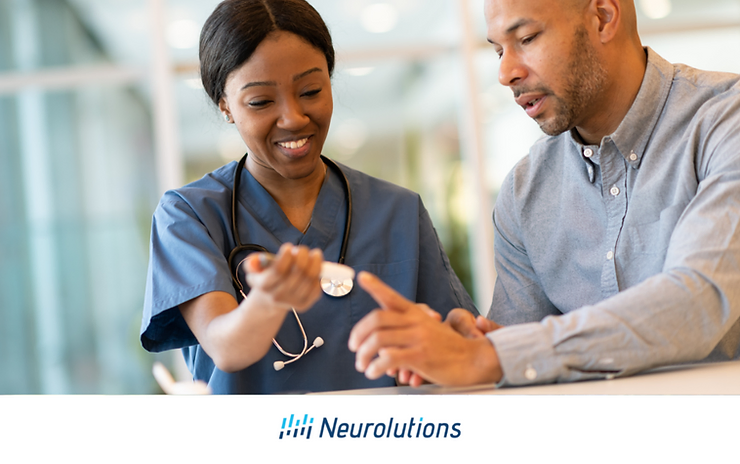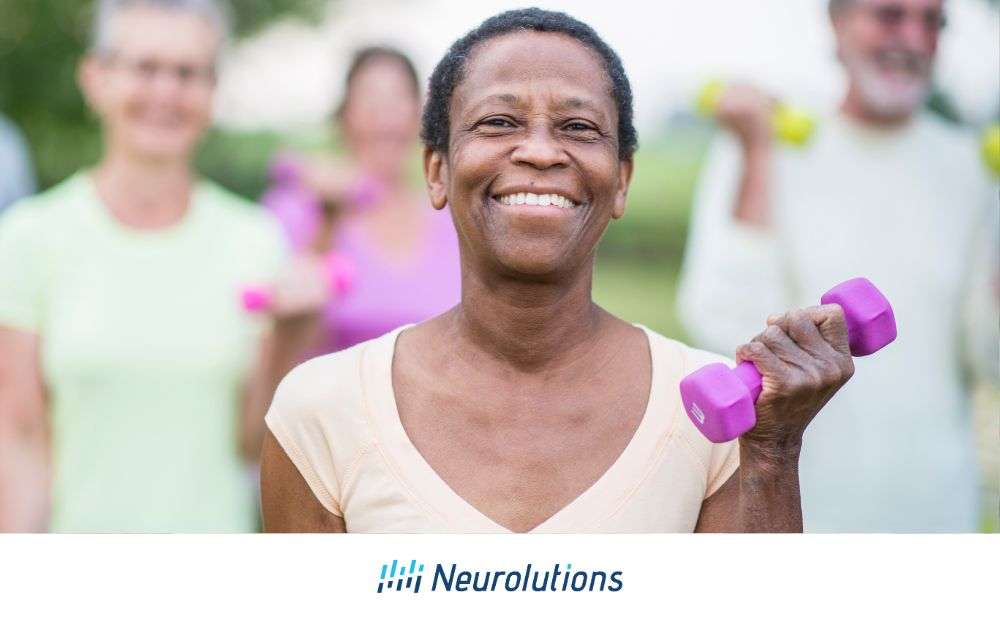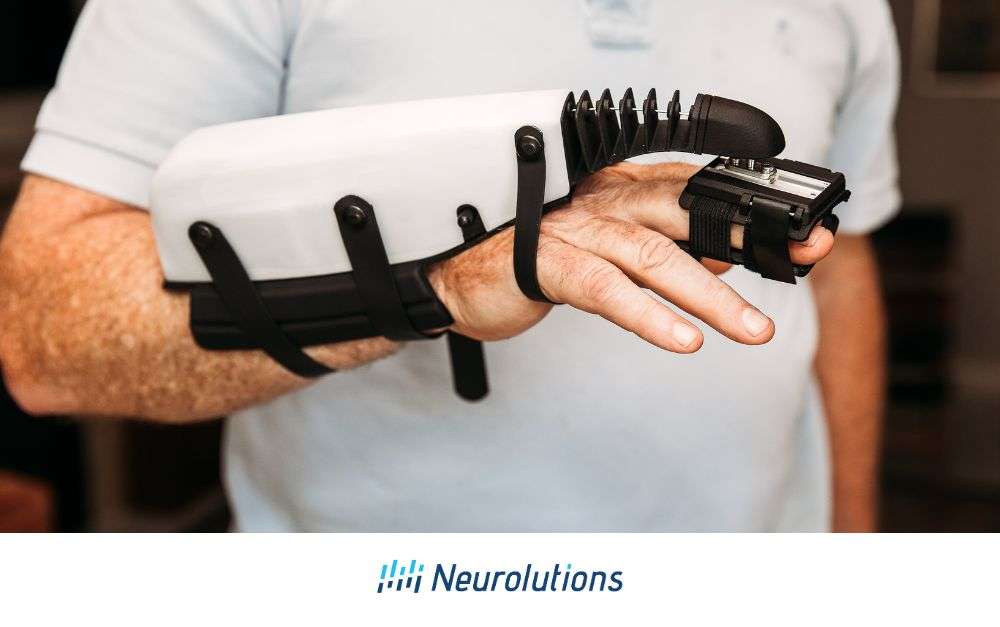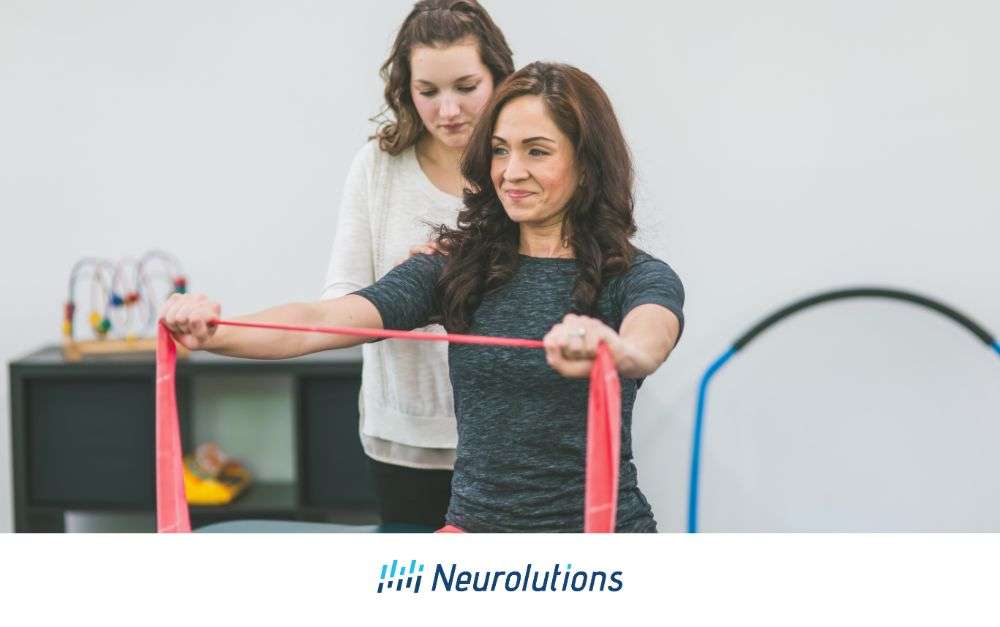About two-thirds of those that experience arm paralysis after stroke are unable to fully use their affected limb six months after stroke (1-3). Not having a fully functional arm and hand after a stroke is not only frustrating but also devastating to many individuals. Day-to-day operations and activities of daily living become more difficult, take longer to complete, and may require assistance from others.
Despite arm and hand paralysis being one of the most persistent deficits stroke survivors face, it is possible for the paralyzed limb to recover function!
These 7-Steps to Recuperation from Stroke Arm Paralysis are contributions from experts in stroke recovery, research studies, and best practice guidelines.
1. Understand The Root Cause Of Arm Paralysis
Arm and hand control via billions of brain network connections is a very sophisticated process. When there is interrupted blood flow to specific regions of the brain’s cortex that control planning and execution of movement, arm and/or hand function will suffer. In fact, the amount of commands and actions it takes for the upper limb to perform a basic task, like reaching for a cup, is more complicated than moving the lower limbs to take steps.
Although healthcare professionals provide education to stroke survivors and their families that a stroke caused the arm to be paralyzed, there are often misconceptions about the reality of the situation and treatment options for recovery.
Remember that the root cause of the problem is in the brain, not the arm. In other words, even though sudden and chronic stroke symptoms outwardly may surface in the arm, the brain tissue is what was attacked.
Why should this critical piece of information be constantly reiterated throughout the rehabilitation process? Because the brain is what needs to be worked on. To work the brain, one must work the arm; to work the arm, one must work the brain.
2. Connect With Supportive People
Building a tribe that supports a holistic outlook of stroke recovery is highly important. Connect with people that reinforce healing messages, offer healthy perspectives, and help you reach your goals. Create an A-team out of physicians, therapists, family members, friends, and even other stroke survivors to be your advocate, provide recommendations/resources, and give you encouragement. You may need them for venting as well. There are times that you may not want to do something out of fear of failure or because of the anticipated demand of effort. However, those who understand stroke recovery provide encouragement to keep going if it is in the best interest of achieving the goal.
Let them know your goals so they can support you on your journey. Ask your support team NOT to do everything for you when it comes to tasks that involve the weaker arm. As long as safety is not compromised, it is important to have your support team allow you to “struggle.” Struggle and effort are just one of the ways the brain forms new connections to restore function. Otherwise, the brain will figure out a way to make it easier. Compensation will otherwise set in quickly and become a newly formed habit. Unfortunately, habits are hard to unlearn. Your support team needs to know what they can do to help you restore arm function, whenever possible.
3. Search For Other Survivors’ Stories
It is possible to learn a lot from individuals who have traveled the road before you. Searching for stroke survivors’ stories not only helps you realize you are not alone, but it also helps you gather ideas to find out what other people are doing to promote their own recovery.
Social media can actually be a wonderful tool to view posts of stroke “warriors” going to battle in rehabilitation. Survivors that are willing to post videos or share stories shed a lot of light on rehabilitation centers, advanced technology devices indicated for stroke, and techniques that worked (or did not work) while adapting to this new chapter of life.
Starting rehabilitation in an environment that serves the stroke or joining a stroke support group may also help you find survivors to connect with and learn what they are doing for their stroke arm recovery.
4. Educate Yourself On Arm Recovery After Stroke
Some studies have concluded that the prognosis of hemiplegic arm recovery six months post-stroke can be predicted as early as 72 hours after stroke onset with simple bedside tests (finger extension, straightening the elbow, raising the arm out to the side) (4,5). While guidance that comes out of the research provides more understanding into the window of recovery after stroke, it is important not to allow prediction models to limit the survivor’s potential. Numerous factors can still influence the restoration of arm function. These may include but are not limited to, access to quality stroke rehabilitation, frequency, and continuation of visits, discipline with the home program and use of the arm, motivation, tolerance to work and/or effort during rehabilitation, and even use of advanced technologies designed to accelerate recovery.
Stroke survivors well into the chronic phase can and do make progress enough to matter in their day-to-day life. Not only has it been shown in emerging research, but functional improvement occurs in chronic stroke survivors on a daily basis without it being publicly tracked across the globe in homes and facilities. For more information, refer to our Complete Guide to Chronic Strokes.
Principles Of Neurorehabilitation and Stroke Paralysis Recovery
Stroke survivors and rehabilitation healthcare practitioners are encouraged to utilize principles of neurorehabilitation after stroke based on motor learning and brain plasticity mechanisms. These principles synthesized from an expansive literature search may promote lasting, neuroplastic changes in the brain for regaining arm movement after stroke. These principles include, but are not limited to (6):
- Mass practice (i.e. grouped, high repetition to promote learning)
- Spaced practice (i.e. structured rest periods between practice)
- Dosage (i.e. how often training occurs)
- Goal or task-oriented practice (i.e. training centers around a true goal/task with a defined outcome)
- Challenge (i.e. tuning the dial on the task difficulty level to “just right” to promote brain change without causing excessive frustration)
- Multisensory stimulation (i.e. incorporating multiple senses from various systems (vision, proprioception, tactile stimulation, etc.) in order to assist with motor planning and execution of “loops” between the brain and affected arm/hand)
- Rhythmic cueing (i.e. strategic use of pace/tempo during training to tap into brain circuitry centers responsible for cadence, sustaining task, etc)
- Knowledge of results (KR) (i.e. use of external feedback about results and goal achievement; KR is used as reinforcer “do better” on subsequent rounds of practice or to guide future decision-making)
- Knowledge of performance (KP) and knowledge of results (KR) (i.e. feedback that is used to understand performance/quality (KP) and goal attainment (KR). Both feedback methods are important in motor learning for acquiring skills.)
- Use of the arm versus compensation (i.e. use it to improve it, use it or lose it; pain, learned behaviors, and effort required to use the paralyzed limb may discourage use and promote disuse, causing a cascade of further physical and even emotional impairments)
- Action observation (i.e. observation of a real or animated individual or individual’s hand performing the movement to activate certain brain networks responsible for planning movement to lead to reduced impairment)
- Motor imagery (i.e. mental rehearsal of movements to induce learning-dependent brain changes).
Outside of the scope of this article to fully detail, these approaches and conditional terms of how and when to apply the above principles to promote recovery from stroke arm paralysis are still being investigated. Nevertheless, stroke survivors should work with their therapists to individualize a rehabilitation approach with the best available education and knowledge.
Finally, efficacious treatment interventions promote recuperation from stroke arm paralysis. The following list does not detail the specifics, but for further information and discussion, refer to best practice guidelines from Stroke Rehabilitation Evidence-Based Review and Guidelines for Adult Stroke Rehabilitation and Recovery.
Therapy Interventions That Help Regain Movement After Stroke
- Stretching and range of motion (ROM) exercises
- Optimal positioning of arm/hand (in case of support for the very weak arm, subluxation of shoulder, contracture management, and enhancing limb awareness)
- Resistance training
- Constraint-Induced or Modified Constraint Induced Movement Therapy (CIMT, mCIMT)
- Electrical stimulation
- Sensory reeducation with sensorimotor training to improve tactile (sensation) feedback motor planning sensory and proprioceptive (knowledge of limb position) awareness.
- Mirror therapy
- Mental practice/mental imagery
- Action observation training
New and promising research is emerging at a rapid rate, especially in the field of advanced technologies studying the effects of virtual reality, brain-computer interface, non-invasive brain stimulation techniques using electrical current, and vagus nerve stimulation. It is important for survivors and health care practitioners to stay current as the gap between research and clinical practice closes with new understandings and access to the technology as the industry field brings it to market.
Finally, your physician should educate you about various medications that may help reduce your arm pain or improve muscle relaxation to help promote functional use, increase ease of ADLs, and/or prevent contractures. While there is not a magic pharmaceutical product that cures arm paralysis, sometimes individuals benefit from medications tailored to meet their clinical presentation. Education on available options while weighing out risk is critical.
5. Find The Right Stroke Rehab Center For Your Needs
Convenience is often considered a top priority when selecting where to go for your rehabilitation needs. Travel time and burdens associated with it may play into whether or not a person will stick with their rehabilitation. Before simply finding the closest center to your home that offers physical, speech, or occupational therapy, do your homework to find a location that has experts in implementing stroke rehabilitation and also has the resources/equipment to support advancements in the field. Investigate the wait list time, find out all insurance information in advance, and ask for a tour. While you are on your tour, speak with participants of the program and ask how they like the facility and what they are doing in their treatment. Remember that depending on who you talk to, you may get very different stories because of your own unique experiences. Additionally, ask to speak with clinicians that can provide an overview of what they offer. They will most likely not be able to give you specific information about your tailored care plan until you are properly evaluated.
Telehealth and telerehabilitation options are becoming increasingly popular. They may be covered in your insurance plan, and they might also be offered at top stroke hospitals. Check to see if you are in network, or if you can afford a few out-of-pocket visits, the education received from the visits may be enough to be a good jumping-off point to further your rehabilitation in a local area.
- For a list of stroke rehabilitation hospitals in America, see here: Choosing the Right Stroke Rehab
- For a list of Certified Stroke Rehabilitation Specialists (CSRS) made of physical and occupational therapists, refer to this website for name/location: CSRS Therapist Finder
6. Improve Your Mental Health & Happiness To Increase Recovery Speed
Due to a number of biochemical, personal, and social interactions, depression and anxiety may be present in the aftermath of a stroke. Because there is such a prevalence of stroke survivors experiencing chronic arm and hand paralysis, exploring how to support the needs of those living with paralysis is critical.
One of the things to consider is happiness can develop through the practice of finding your confidence again. What does this mean? When a person develops a healthy “can do, nothing is going to stop me from reaching my goals,” amazing things can happen and depressive thoughts may diminish.
Try not to let how you feel dictate what you do, but rather let what you do dictate how you feel. Put in the work to increase your opportunity for recovery at regaining function in your arm. Besides being in a greater level of “happiness,” you may find other positive characteristics accompanying the trend, such as having hope, determination, discipline, and mental toughness.
For other ideas, read Finding your Confidence after Stroke
7. Actively Participate in Occupational Therapy and Physical Therapy Rehabilitation
It is highly important to enroll in rehabilitation services (i.e. occupational and physical therapy) to work the brain and restore function in the paralyzed limb after the onset of stroke. Inpatient therapy will design activities that promote the use of the paralyzed arm, but the primary focus of inpatient rehabilitation is equipping the stroke survivor and their families with techniques to improve independence, enhance safety, and reduce caregiver burden so the individual can be released from the hospital. That means in-home care or in outpatient therapy, you and your therapist must start working harder than ever on your paralyzed arm.
How to be actively involved in your rehabilitation:
Set Goals With Your Therapist.
What do you need and want to do with your arm in order to help you re-engage with daily activities and occupations? A good therapist will ask you this and incorporate your personal, relevant goals and activities into care. Meaningful activities not only hold your interest longer, but our brains learn and retain information best from relevant experiences.
Work Hard During Therapy. Work Hard Outside Of Therapy.
The amount of time you spend outside of therapy is greater than the time you spend in therapy. Use all the “downtime” minutes to address purposeful activities. Also, feel empowered to make your own decisions and (safely) try new things. Report back to your therapist so they know what you have been doing outside of your session. They will be able to make judgments about future training sessions.
Bring An Eager And Determined Mindset To Your Therapy Sessions.
Every day is an opportunity to make more progress!
Come Prepared With Information To Share With Your Therapist.
Start an impactful conversation by sharing pertinent pieces of information about your recovery journey. Try sharing the following:
- What have you tried recently that exceeded your expectations of personal performance, and why?
- What have you tried recently that was below your expectations, and why?
- What is one thing that you know you should be doing more of that you know would provide benefit? What is a “blocker” from doing so?
- Is there anything that you recognize holding you back from one or more of the goals you have set for yourself? Have you considered ways around the problem?
Although these are just a few examples, these exploratory questions will heighten self-awareness and be a good jumping-off point to address in therapy. Sharing them with your therapist may help strengthen your therapeutic relationship. As a bonus, this will motivate both of you to foster a “Teamwork makes the dream work!” attitude.
It is possible to recuperate from stroke arm paralysis. While degrees of recovery and function will vary from person to person, your limits do not need to be defined by timelines and comparisons of other individuals. It is important to stay motivated and stay positive on your journey and remember to show up for yourself. In the words of Napoleon Hill, “whatever your mind can conceive and believe, it can achieve.”
References
1. Lawrence ES, Coshall C, Dundas R, et al. Estimates of the prevalence of acute stroke impairments and disability in a multiethnic population. Stroke. Jun 2001;32(6):1279-84.doi:10.1161/01.str.32.6.1279
2. Sunderland A, Tinson D, Bradley L, Hewer RL. Arm function after stroke. An evaluation of grip strength as a measure of recovery and a prognostic indicator. Journal of neurology, neurosurgery, and psychiatry. Nov 1989;52(11):1267-72. doi:10.1136/jnnp.52.11.1267
3. Wade DT, Langton-Hewer R, Wood VA, Skilbeck CE, Ismail HM. The hemiplegic arm after stroke: measurement and recovery. Journal of neurology, neurosurgery, and psychiatry. Jun 1983;46(6):521-4. doi:10.1136/jnnp.46.6.521
4. Nijland RH, van Wegen EE, Harmeling-van der Wel BC, Kwakkel G; EPOS Investigators. Presence of finger extension and shoulder abduction within 72 hours after stroke predicts functional recovery: early prediction of functional outcome after stroke: the EPOS cohort study. Stroke. 2010 Apr;41(4):745-50. doi: 10.1161/STROKEAHA.109.572065. Epub 2010 Feb 18. PMID: 20167916.
5. Ghaziani E, Couppé C, Siersma V, Christensen H, Magnusson SP, Sunnerhagen KS, Persson HC, Alt Murphy M. Easily Conducted Tests During the First Week Post-stroke Can Aid the Prediction of Arm Functioning at 6 Months. Front Neurol. 2020 Jan 9;10:1371. doi: 10.3389/fneur.2019.01371. PMID: 31993016; PMCID: PMC6962352.
6. Maier M, Ballester BR, Verschure PFMJ. Principles of Neurorehabilitation After Stroke Based on Motor Learning and Brain Plasticity Mechanisms. Front Syst Neurosci. 2019 Dec 17;13:74. doi: 10.3389/fnsys.2019.00074. PMID: 31920570; PMCID: PMC6928101.




